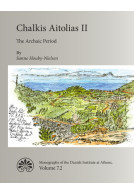The Ancient Harbours of the Piraeus (Hardback)
Volume II. Zea Harbour: the Group 1 and 2 Shipsheds and Slipways - Architecture, Topography and Finds
Imprint: Aarhus University Press
Series: Monographs of the Danish Institute at Athens
Pages: 252
Illustrations: 37 figs., 32 plates
ISBN: 9788771848021
Published: 20th July 2019
Script Academic & Professional
Series: Monographs of the Danish Institute at Athens
Pages: 252
Illustrations: 37 figs., 32 plates
ISBN: 9788771848021
Published: 20th July 2019
Script Academic & Professional
You'll be £58.00 closer to your next £10.00 credit when you purchase The Ancient Harbours of the Piraeus. What's this?
+£4.99 UK Delivery or free UK delivery if order is over £40
(click here for international delivery rates)
Need a currency converter? Check XE.com for live rates
(click here for international delivery rates)
Need a currency converter? Check XE.com for live rates
Volume 15,3: Architecture, Topography, Finds. Expanding on the publication of the shipsheds and slipways found in the northern half of Group 1 (Area 1) on the eastern side of Zea Harbour in Volume I.1–2 (2011) of the peer-reviewed Ancient Harbours of the Piraeus series, Volume II presents further results of the archaeological investigations conducted by the Zea Harbour Project (ZHP) in 2004-2010 and 2012 of ancient shipsheds and slipways in Zea Harbour (Pashalimani), both identified and possible, making them the best documented structures in Athens’ naval bases and in the wider Mediterranean. Approximately half of Volume II is devoted to the remains of shipsheds and possible shipsheds in the southern half of Group 1 (Area 2), while studies of structures identified as wide unroofed slipways in Group 2 (Area 3) on the south-eastern side of the same harbour basin occupy the balance of the book. After Chapter 1’s introduction to terminology and methodology, Chapter 2 presents the architecture of the shipsheds and possible shipsheds found in the southern half of Group 1 (Area 2), along with the arrangement and topography of this massive naval complex, which in the 4th century BC covered between 11,630 m2 and 11,989 m2. Chapter 3 examines and catalogues the ceramics and other small finds discovered in the same area, discussing their excavation contexts, composition, and chronological significance. Chapter 4 focuses on the architecture and topography of seven wide, unroofed slipways found in Group 2 in the northern part of Area 3 that represent a building type previously unknown in the Piraeus, probably designed either for a larger warship known as the penteres (‘five’), introduced into the Athenian navy between 329/8 BC and 326/5 BC, or for a larger Hellenistic-period warship type. Chapter 5 analyses and catalogues the ceramic small finds recovered during the excavation of the structures featured in Chapter 4. Chapter 6 presents the new evidence regarding relative sea-level change in the harbours of Zea and Mounichia and its impact on the reconstructed lengths and layouts of the slipways and shipsheds at Zea in Group 1 (Areas 1–2) along with the wide slipways of Group 2, including greater accuracy in the recalculated lengths of the Group 1 shipsheds and slipways presented in Volume I; furthermore, it reaffirms the validity of the ZHP’s methodology and published results in relation to shipsheds around the Mediterranean. Chapter 7 recapitulates the authors’ topographical, architectural, and chronological conclusions regarding the complexes at Zea and Mounichia, which contain the only identifiable shipsheds for triremes anywhere in the ancient world. Descriptive catalogues of the Area 2 and 3 quarries and Area 2 trenches (Appendices 1–2), Figures, and Plates complete the volume.
Customers who bought this title also bought...
Other titles in the series...
Other titles in Aarhus University Press...
















